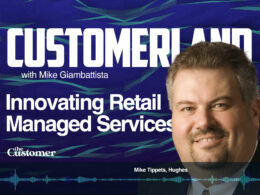How can data-driven insights create trust and foster lasting customer relationships? Join us as we sit down with Nikola Mijic, CEO and co-founder of Matik, who shares his expertise on infusing data into every point of the customer journey. Drawing from his experience at LinkedIn, Nick reveals how data has been integral in building credibility and trust with customers, ultimately leading to better business outcomes.
But what about the challenges surrounding data access and making sense of it all? That’s where our conversation takes an exciting turn as we explore the importance of customer success and continuous improvement. Discover how a strong listening process lies at the heart of every customer success effort, and how being flexible and adaptable can help your company identify unique changes catered to your customers’ needs. Don’t miss out on this engaging discussion with Nikola Mijic, and uncover the secrets to building trust through data narratives!
Full transcript below
Mike Giambattista
I’m talking with Nikola Mijic, who is CEO and co-founder of a company called Matik, and Matik, if I get this right, produces automates, data-driven presentations to make it what would have been a day-long, week-long, sometimes month-long process into a couple of clicks. Did I get anywhere close to write on that?
Nikola Mijic
No, I think that’s spot on. Yeah, our goal is to really automate those data-driven narratives which are presentations. today, We also have email capabilities as well, whether it is a business review that you’re sharing with a customer or a renewal deck that goes over the value. Our hope is to be able to create data-driven content in order for you to build trust with your customers and prospects.
Mike Giambattista
So we started this conversation talking about our respective backgrounds out of the country and such, which don’t really have anything directly to do with retaining customer trust. On the other hand, i actually think they do, because so much of what is at the core of healthy customer relationships is based on a healthy sense of empathy, of being able to understand your counterparts, and what they’re going through At the moment, at their point in whatever customer journey they’re going through, informs so much of how a company is going to handle that and it boils down to an individual basis. So I don’t really think I’m tying things together that shouldn’t be tied together To me. It all kind of works in my head And I wanted to talk with you a little bit about your views of customer relationships, specifically customer trust and even more specifically, what it takes to build and retain that customer trust Makes sense.
Nikola Mijic
Yeah, i mean I can definitely jump into that and to maybe kind of set the stage a little bit of how I’ve informed my way of thinking here, I’ll take a little bit in my background. Prior to starting MATIK, i was at LinkedIn, where I worked on building out internal tools and narratives for our sales and customer success teams, and then, for that work that a customer success tech software company, right. So I’ve always supported sales and customer success and I’ve worked in companies whose main objective was all around customer success. So building that trust has always been part of our DNA And I think, specifically calling my experience at LinkedIn, i just realized how much I’ve touched data, the importance data plays in building that trust.
Right, I think this isn’t anything novel, but data is everywhere. That’s how we make decisions now and at LinkedIn in particular, we infuse data across every single touch point in the customer lifecycle, whether it was pre-sales, like a pitch deck, whether it was post-sales onboarding, value realization, renewal decks business reviews were extremely data driven And what we found was that it not only helped us build credibility and trust that you alluded to a little bit earlier with our prospects and customers, but it really led to better business outcomes, right. The hope is that, if you’re building trust and you’re doing it properly, that it does lead to better business outcomes, like higher renewals right, lower churn, higher adoption things that are going to be moving the needle for you and your business.
Mike Giambattista
I’d love to hear about your experiences at LinkedIn, but also how this is getting played out at Matik, because one of the most universal issues that people I speak with have to deal with is not so much the data. The data is there. There’s an awful lot of it. It’s getting your hands on it and then being able to do something with it. It’s turning that into insights and then a product or then a service, then a response, that kind of thing, And that seems to me to be where I mean I can list off. Of the past 20 interviews that I’ve done, 18 of those have been right around the core topic of data transportability and actionability. So how did that play out at LinkedIn and how does that play out at Matik?
Nikola Mijic
Yeah. So I mean, i think you are right. I think we do have access to data to a certain extent, but what I found at LinkedIn and even prior companies that I worked for, and even just what we hear in the market consistently is let’s take a particular touch point, let’s say, like a business review, right, so you may have a template that your customer success manager is account managers that says, hey, here’s the ideal business review, here’s the formatting, here’s the data points that we want you to include, here’s how we want you to talk about the data. And you, as a customer success manager, will make a copy of that template. And then there are placeholders that will say, okay, go to Tableau to get this chart, go to the CRM Salesforce, Hubspot to go and get this data point. Go to Nick, he’ll pull this data for you in the database and put it in Excel, do your thing. And so it’s not necessarily having access to the data, it’s just it’s in a variety of different places that you have to go to, which is really cumbersome.
And then the second part, which I think you mentioned, was how do I then make sense of it right And tell the right story at the right time? So I think we found that to be an issue at LinkedIn And that’s what caused us to go and automate that process, because we found that our teams are spending so much time putting together this data driven content right. But on the flip side, we saw the impact that it was having right. So, in order you know, why automate something if it’s not going to have an impact? And we did see that when we won our CSMs, when our account managers or our AEs were using data in across the different touchpoints in the life cycle, that it built better relationships with our customers and it led to those business outcomes that we mentioned here. And you know, we see that with MATIK And I think in today’s world, right in the macroeconomic environment, the need to be able to show value And specifically through data, is now like table stakes, right.
If you are looking to purchase a offering or you’re looking to renew some sort of offering, you know procurement teams, CFOs they want to know like Hey, did we receive value from your product or service And what does that look like? And a lot of the times, you have to be able to tie that data to those value and the objectives that they had initially of why they purchased your product. And so, again, it goes back to building that trust. If you are able to translate that data and tell a cohesive story about value, then it makes those conversations a lot easier, especially when it comes to renewal or conversion.
Mike Giambattista
I’m curious as to what you mentioned. The process was basically assembling data from these disparate points and automating. Basically I’m going to call it a storyline And automating was. I’m not going to, I’m not going to knock the difficulties of assembling data from different points. It’s very difficult and a lot of companies really struggle with it. But there’s also a real problem that needs to be solved in terms of how do you create that storyline. That’s the narrative, and it seems to me because I have to deal with this fairly frequently in this world is that if there’s a way to automate that part of it, that’s an actual game changer.
Nikola Mijic
Totally Yeah. And I think what you’ll find is, in order to scale, you have to standardize. So that’s why you create templates. So if I’m a 1,000-person company and I’ve got 100 customer success managers and I want them to follow a playbook, i need to make sure that I’ve got these templates identified. There has to be some sort of repetitive nature in order for you to really scale. You can’t just throw bodies at the problem. And so you are right, i think most companies have some sort of a story that is repetitive in nature that they want to tell across their customer base, but what they lack is the automation to go and do that.
And you know there’s always I always say 80-20, right, you want to automate as much as possible, and I would say the emergence of AI is going to help us get closer from 80-20 to potentially 95-5, right, or even 100 percent, where, hey, you know you can have rule-based logic that will say, hey, if this data point is below a certain threshold, delete this entire slide, show this slide right, like that’s doable today.
But with the emergence of AI, you know there could be a world in which you know we populate a presentation and we give you an exact summary, right, based on all the data that we’ve populated, and that’s kind of the key takeaway or the insights that you talked about. So I actually think we’re really, really close to getting to closing, or closing that gap. For that 80-20 to be closer to 95-5, right, but I would argue that you do need, in order for a business to scale, you got to find ways for it to be standardized, or else the only way to really scale is just hiring more people, and we know, in today’s economic climate, doing more with less is really kind of the main objective that most companies are looking to do, right?
Mike Giambattista
Sure, I was reading one of the data points on your site a little earlier from Glassdoor 190 hours saved per week, the equivalent of five additional analysts. 16,000 presentations delivered data-driven insights to more than 4,000 Glassdoor customers, which equaled roughly 10,000 analyst hours saved in the past year. I mean I keep reading the data points, but that’s a big deal. Yeah, yeah, yeah, so I can see where you know. If you know those numbers would probably skyrocket once some of these new AI based tools are implemented and you know things really do become fully, fully automated. It’s just a really interesting moment to be to have a tool like yours on the market when so many of these AI applications kind of directly speak into it.
Nikola Mijic
Yeah, and you know, like I said, i think most companies are looking at infusing AI into their product or services And we really do feel like there’s a lot of synergy with us to incorporate AI, not just, you know, hey, we’re doing AI for the sake of doing AI, but I do think that there’s a lot of things that can be enhanced within our product or service with artificial intelligence And that’s something that stay tuned will be, will be announcing, hopefully in the coming months. Yeah, you know, i think those stats that you just alluded to I think is a great depiction of the value of automation, right? Glassdoor has an insights team that supports their sales and customer success And they were having to pull all this data. They were having to put together all this data for their customers And they were able to scale that and make itself serve for their customer success managers to go and pull a presentation that pulls in all the data for them, formats everything within a few clicks, and so instead of hiring more people.
You know they were able to do it through automation And that’s, you know, that’s something that we want to put our you know that we really want to focus on is really allowing our customers to do more with less, especially in today’s macroeconomic environment.
Mike Giambattista
I’m going to make a prediction that I have no right to make, but in looking over some of your materials and familiarizing myself with the offering, it’s a little bit surprising to me that someone like Microsoft, who’s behind PowerPoint, hasn’t just said we want it, let’s just write a check, let’s buy Matik. And I don’t want to know if you’re already in conversations there, but I predict that those conversations will happen soon, if they haven’t already.
Nikola Mijic
Yeah, and like we’re agnostic, right, we were compatible with both PowerPoint and Google slides. So our the output of Matik, when you go and generate something, is a totally native presentation in PowerPoint and Google slides, and I think that’s one of the things that our customers and our end users really love is is that, hey, they’re not learning a net new tool on. You know, like I said, we’re not a new presentation. They’re familiar with Google slides and PowerPoint. We’re just, you know, helping them automate, pulling in all the data and helping them create a story that they then ultimately present to their customers.
Mike Giambattista
Oh was. I had an email exchange with one of your team members in advance of this conversation and they said something in the effect of Nick loves to talk about how you can launch a customer success from scratch and become a trusted advisor. So is there a just add water solution to customer success? Sorry, that last part. Is there a just add water solution to customer success? or rather, maybe just you know from what you see at Matik and your, your, your prior life at LinkedIn, et cetera, or for mid-sized companies that may be fairly new and early on the timeline of customer success efforts, what can they learn from your efforts?
Nikola Mijic
Yeah, I mean, I think, people who are early or starting out and are early on in the process. I think you really want to make sure that you are close to the customer, right, and so that means not necessarily doing probably more listening, right, so really understanding what are the common objectives of why your customers are buying your product or service, right, and try to codify that. And then I think, from there, i think one of the biggest things, especially early on, is tying it back to value realization, right, like how does your customer realize value? And then being able to associate data to those things to be able to measure and quantify. That, i think, is huge, and so people that are starting out early on, i always advise like listen to your customers, try to understand why they bought and then really determine where value is being realized and associate your data, whether it’s usage on how they’re using your software or the impact in terms of using your service. It doesn’t have to be software necessarily, right, and then from there you are able to test and iterate on stories that you can share with your customers.
But I think, early on, i think the biggest thing is you know, listen to your customers right, and understand what they’re trying to accomplish and ultimately it goes back to like, why did you buy? And then being able to tie value to those objectives of why they bought your product or service. So, and then you know, just like anything else, iteration, iteration, iteration. You know, what you probably start with is not the end state. I would argue that there never is, and that’s the fun in it, right, like? I think that’s one of the things that I really enjoy about this space is it’s fluid, it’s organic, it’s constantly evolving, and I think you do have to adapt and you do need to look at how you’re, how you’re the processes that you have in place and how you can continue to improve them. And it’s not, you know, it’s not an end state. It’s always. It’s fluid, it’s always going to be evolving.
Mike Giambattista
So what you’re describing here is something that looks kind of like a ready aim fire process, as opposed to the one that seems to be very pervasive, which is ready fire aim in terms of customer success. I mean, you know, every customer success effort is built around a listening process, but I can’t tell you how many I have learned of through these products, through these conversations, where listening was bolted on to the process a little bit later on.
Nikola Mijic
How interesting Okay.
Mike Giambattista
Yeah, and that’s actually fairly common. I don’t know if a lot of you would admit that, but that’s you know yeah, and it is.
Nikola Mijic
Every company is different, right? So what works for company A might not work for company B, right? I think that’s where I would argue. The listening upfront will help you identify right where, where you need to do something that’s unique to yourself, versus you know something that you can copy from prior experiences or other companies that are in your industry.













